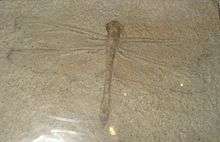Petaluridae
The petaltails of the family Petaluridae are apparently the most ancient of the extant true dragonflies (infraorder Anisoptera), having fossil members from as early as the Jurassic (over 150 million years ago).

| Petaluridae | |
|---|---|
| Tanypteryx pryeri | |
| Scientific classification | |
| Kingdom: | Animalia |
| Phylum: | Arthropoda |
| Class: | Insecta |
| Order: | Odonata |
| Infraorder: | Anisoptera |
| Family: | Petaluridae Needham, 1903[1] |
| Genera | |
| |
Modern petalurids include only 11 species, one of which, the Australian Petalura ingentissima, is the largest of living dragonflies, having a wingspan of up to 160 mm and a body length of over 100 mm. Other Australian species include Petalura gigantea (commonly known as the giant dragonfly). In the United States, two species are found, one on either coast. The larvae live primarily in stream banks, mostly in burrows, but the larvae of the eastern US species, Tachopteryx thoreyi, the gray petaltail, live in depressions under wet leaves.[2] The semiaquatic habitat of the larvae makes the petaltails unique in the modern dragonfly families.
Notes
- Dijkstra, K.D.B.; et al. (2013). "The classification and diversity of dragonflies and damselflies (Odonata). In: Zhang, Z.-Q. (Ed.) Animal Biodiversity: An Outline of Higher-level Classification and Survey of Taxonomic Richness (Addenda 2013)". Zootaxa. 3703 (1): 36–45. doi:10.11646/zootaxa.3703.1.9. hdl:10072/61365.
- Paulson, Dennis R. (2009). Dragonflies and Damselflies of the West. Princeton University Press. ISBN 0-691-12281-4.
References
- Silsby, Jill. 2001. Dragonflies of the World. Smithsonian Institution Press, Washington D.C.
- Martin Schorr; Martin Lindeboom; Dennis Paulson. "World Odonata List". University of Puget Sound. Retrieved 11 August 2010.
| Wikimedia Commons has media related to Petaluridae. |